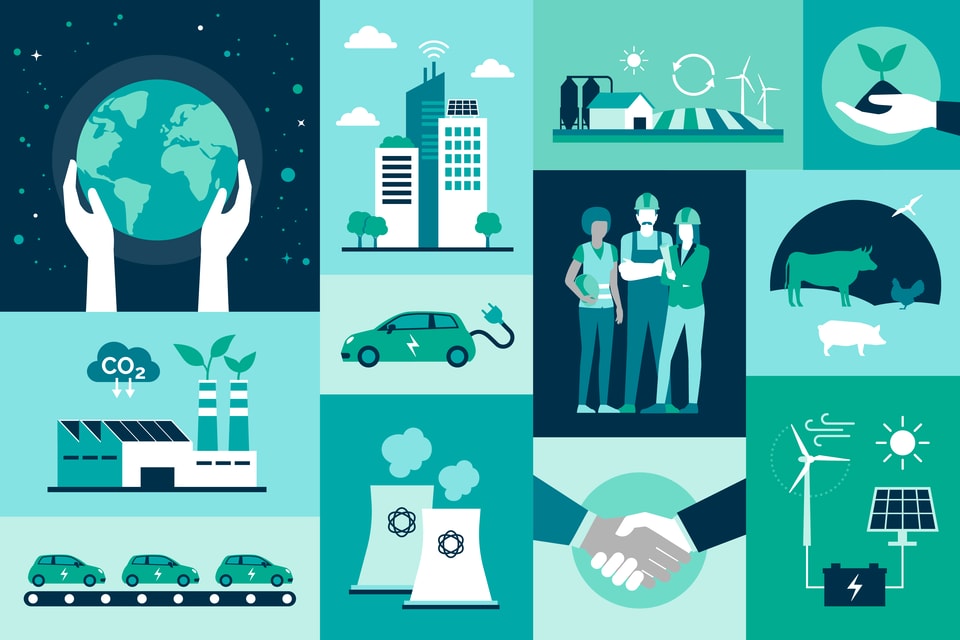Memo Published November 2, 2021 · 10 minute read
Winning the Narrative on Federal Clean Energy Investments
Jared DeWese, Aliza Astrow, & Mary Sagatelova

Key Takeaways
Voters have become increasingly convinced that the government should develop policies to address climate change. Extreme weather events, and a recognition of their disproportionate impacts on frontline communities, have made the threat more personal and urgent. An earlier survey from Avalanche Insights found that an overwhelming majority of voters (77%) recognize the importance of a domestic transition to clean energy. However, our recent polling confirms that while key voter groups support climate and energy investments, economic concerns cast a shadow of doubt on voter perception of a realistic transition to clean energy.
From July 7-15, 2021, Third Way and Avalanche Insights examined how to make the clean energy transition more resonant with voters. The nationwide “listening” survey was conducted among 2,902 registered voters. (See the end for more on the methodology.)
We came away with the three central imperatives for policymakers, advocates, and communicators:
- Tell a story, and don’t get lost in the weeds. Storytelling bested policy recitation with all voters, especially those who were “soft Biden” and even “soft Trump.” This approach outperformed messages that focused on policy details by 19 points.
- Offer a positive vision of the future, not a recitation of our current climate sins. Voters responded far better to a description of where we are headed than to a recitation of what we must move away from. All voter groups cite “for future generations” as one of their top reasons to invest in clean energy.
- Show them how their lives improve if we invest in clean energy. Over a fifth (22%) of respondents cite “improved life & health outcomes” as key reasons to invest in a clean energy transition.
President Biden’s American Jobs Plan (AJP), which is largely included in the Bipartisan Infrastructure Deal (BID) and the Democrats’ budget reconciliation bill (or Build Back Better Act (BBB)), offer an enormous opportunity to tackle the climate crisis. But we found that climate advocates must work to overcome voter skepticism and get them emotionally invested in the clean energy transition. Otherwise, these substantive gains could become political liabilities.
The Big Picture: Support but Reluctance
Earlier this year, the President announced the AJP as transformative legislation that would, among other things bring ambitious investments to the clean energy sector that would create jobs and protect the environment. But did voters know that or buy it?
The Good News: The more Americans learned about the policies in AJP, the more they liked them, including the majority of “soft Trump” voters. A majority (57%) of national voters supported large investments in electric vehicles manufacturing, accessibility, and charging infrastructure, which are all part of the Build Back Better Agenda.
The Bad News: Respondents were not wholeheartedly convinced that a clean energy transition was realistic or would benefit them, often citing concerns around job losses and increased energy costs. Despite newborn support for policies within AJP, only a slim majority (51%) of national voters find them attainable with few “Soft Trump” voters (34%) on board.
After hearing for decades from conservative leaders that shifting to clean energy would damage the economy and ruin the social and cultural fabric of fossil-reliant communities, the distrust is understandable. So, how do policymakers and advocates address that skepticism, generate voter support, and prevent climate policies from becoming a political liability? Our research found that these voters do respond to a narrative that moves beyond dry policy recitation and triggers the sense of hopefulness and unity that Americans brought to the big projects of the last century. This time, it’s about ensuring clean air and a healthy planet for future generations. Here’s how:
Tell a story. Don’t get lost in the policy details.
To counter the “job-killer” messaging of the right, we found the most persuasive narratives include more elements of storytelling and less focus on policy. We tested several clean energy narratives through various “policy” and “storytelling” filters. This one did best:
No matter what we look like or where we come from, we all care about our communities. We want our families to have clean air to breathe and clear water to drink. We want safe, good-paying jobs. And we want all Americans to have the freedom and opportunity to thrive and live safe, healthy lives. A transition to clean energy can help us ensure the future we all want, by creating millions of new good-paying jobs, lowering energy costs, and improving health outcomes, so that every American can support their family and keep their children safe and healthy. By investing in clean energy innovation, our country can prioritize both the health and economic well-being of its people and improve the quality of life for American families and generations to come.
In sharp contrast to a “storytelling” framework, “policy” messaging focused on candid initiatives within AJP, BID, and BBB. For example:
The Biden administration has proposed a transition to clean energy with large investments in electric vehicles and charging stations, improvements to the electrical grid, capping of oil and gas wells, ensuring safe and clean water supply, and access to affordable broadband for all Americans. This will lead to tens of thousands more jobs - in construction, engineering, maintenance, sales, and operations, while supporting even more jobs by growing local economies. By seizing this opportunity and reaping these economic rewards, we can meet both our climate and economic ambitions.
Storytelling outperformed messages based purely on policy (EVs, charging stations, grid improvements, etc.) by 19 points (76% vs 57%). Incidentally, within a storytelling framework, voters across the board saw a more realistic path to clean energy; a 10-point difference against purely policy focused messaging. Voters of all kinds felt an emotional connection or reaction when shown this kind of story at the beginning of the survey, and when they were shown this message later in the survey, their attitudes remained consistent. Compared to policy messaging, narrative content elicited a more hopeful reaction (+6 points) while also reducing voter anxiety (-2 points).
Aside from eclipsing its central theme, narrative messaging outperformed policy-centric messaging in the following arenas:
- More favorable sentiment towards a clean energy transition (+14-point)
- Increased likelihood of sharing messaging on social media (+15 points)
- Heightened sense of priority (+10 points) and elevated sense of urgency for government action (+14 points) for a clean energy transition based on economic significance.
When asked about the message they found agreeable, the “soft Biden” voters responded most strongly to “looking out for future generations” and the “healthy, safe, well-being” parts of the narrative. “Soft Trump” voters responded most strongly to ideas like helping the environment and the planet, and both groups liked the idea that the clean energy transition will help people, their communities, and the country. Finally, all groups responded most strongly to the idea of more and better job-creation and to economic opportunity.
Provide a vision of where we’re headed, not a look back at where we’ve been.
Ok, so what story should we tell? Respondents were far more interested in a message that provided a vision of where we are going and not a review of what we are moving away from, with nearly half (45%) citing “looking out for future generations” as a reason to invest in clean energy. They want to hear about a bright future, not a dirty past or a restrictive present.
Clean energy advocates often have done the opposite, leaning into data and messaging that underscored the depth of the climate crisis and the restrictive policies we need to change course. But we’ve found, in this survey and in prior research, those gloomy narratives don’t resonate nearly as well as a focus on the positive, hopeful aspects of creating a clean future. In 2019, we surveyed voters in rural counties in six states of the Midwest and South, and we found even these traditionally climate hostile voters to be quite supportive of policies that could make a positive difference in their lives or create jobs. This new research reaffirms what we told policymakers in 2019 with the previous research, lead with policies that add options and make those options more affordable and accessible, instead of emphasizing bans and taxes. Voters are far more interested in hearing about the benefits of the clean energy transition rather than its limitations.
Emphasize the connection between the clean energy transition and quality of life.
Voters in our survey liked a holistic narrative that not only talked about how the clean energy transition would create jobs and economic growth, but also how that growth connects to a quality of life for them and those in their community. Half (50%) of all respondents indicated that an overall better, safer quality of life was a reason for investments in the clean energy transition. “Soft Biden” and “Soft Trump” voters responded strongly to the parts of the message that included “health, safety, and well-being,” “protecting future generations,” and “will help the planet and environment.” These outperformed parts of the message focused on “economic opportunity” like “creating more/better jobs and pay”. In fact, storytelling messaging, with its’ focus on safety and health, was cited as influencing voting habits across 70% of national voters. Furthermore, a health theme was found to necessitate the need for swift government action from 71% of voters. As the clean energy transition continues to take shape and more jobs are connected to clean technologies, that could change, but it’s up to communicators and policymakers to help thread that needle for voters. The bipartisan infrastructure deal and the Democrats’ reconciliation package provides an enormous opportunity to do so.
However, the link between clean energy and better health outcomes is increasingly clear to voters. This summer, public health experts warned in The Lancet, The New England Journal of Medicine and the British Medical Journal that climate change was the most urgent threat to global public health. Understanding that this is a key component to how voters are thinking about the issue, advocates should seek out additional resources from experts like those at Harvard T.H. Chan School of Public Health C-Change. And groups like WE ACT for Environmental Justice and the Just Transition Fund have on the ground experience with communities struggling both with the health and economic impacts of a clean energy transition.
Conclusion
Even as Americans grow more certain about the impact that climate change will have on their lives and communities, they remain skeptical that the federal government will be able to address the problem with a solution that is realistic, practical, and in a way that benefits them. Policymakers and advocates should tell a forward-looking story about how clean energy not only will benefit Americans economically, but also holistically, improving air quality and overall health.
Methodology
Third Way partnered with Avalanche Insights to conduct a national “listening survey” on voters’ sentiments on climate and clean energy topics. These include open-ended questions where voters can share sentiments in their own words, as well as close-ended questions. This survey has a base sample of 2,970 registered voters. The survey was conducted July 7–15, 2021.


